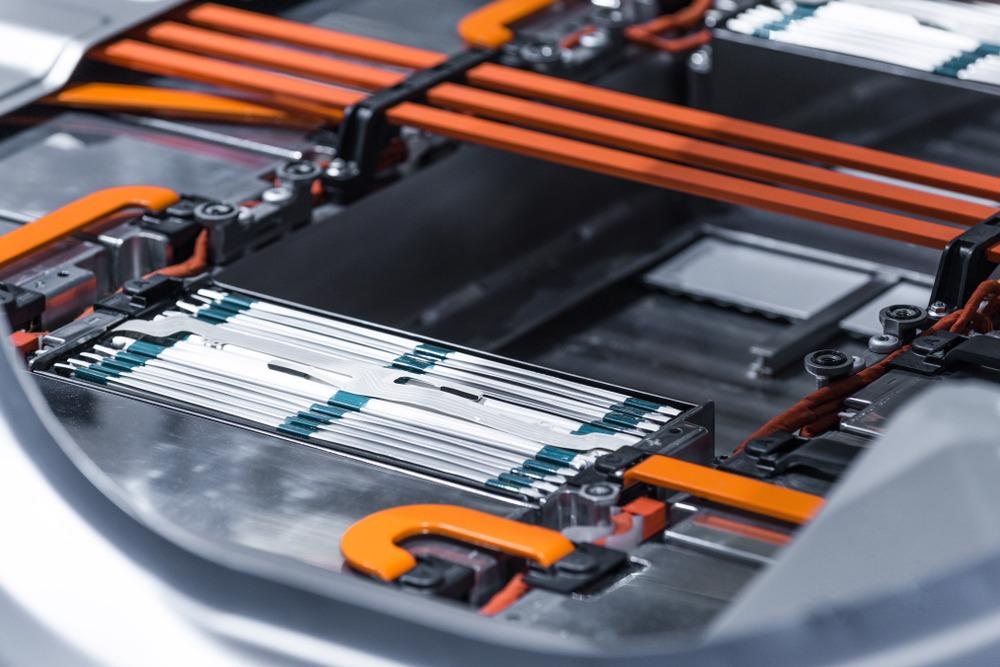
Image Credit: Sergii Chernov/Shutterstock.com
Graphite is commonly used as a material for anodes in lithium-ion batteries, but increasingly, silicon-carbon composites are being suggested as a promising alternative material due to their high theoretical storage space capacity in comparison with that of graphite, as well as large volumetric capacity, a fairly low discharge voltage, and lower cost.
Promising silicon-carbon composites with low innate electric and ionic conductivity are problematic in terms of large changes in volume that occur during the course of lithiation-delithiation fabrication processes, resulting in the pulverization of silicon and subsequent capacity decrease of the electrodes. The pairing of silicon with carbon features a favorable combination of both materials, including the high lithiation capacity of silicon, as well as the exceptional mechanical and conductive qualities of carbon. Researchers in this area have said silicon-carbon composites are the most promising candidates for next-generation lithium-ion battery anodes.
Siridion Black: Silicon-Carbon Composites for Lithium-Ion Batteries
In February 2021, the Germany-based chemical company Evonik introduced one particularly promising silicon-carbon composite for lithium-ion batteries called Siridion Black. Used as an anode material, the company said it can make batteries more powerful by boosting energy density, enhancing the fast-charging capability, and boosting energy efficiency.
The new silicon-carbon composite for lithium-ion batteries is made up of individual spherical particles several hundred nanometers in diameter. The concentration of carbon in each particle increases from the inside out, which helps ensure exceptional stability. Moreover, due to the high level of carbon on the exterior, the particles are better shielded from oxidation and easier to fabricate.
Siridion Black facilitates customized battery solutions, Evonik said. Anode and battery manufacturers should be able to take advantage of the silicon-carbon composite’s significant adaptability to craft battery power solutions that suit their particular needs.
Until now, graphite has been the first choice for anode material in lithium-ion batteries, but demands are changing and electric vehicle batteries, for instance, demand both higher capacity and faster charging. As a component material, the new silicon-carbon composite from Evonik could be quickly built into common anode designs and production operations. The company said it also functions well with other common battery materials.
Siridion Black is just one product in Evonik’s full range of battery materials, which includes cathode material and metal oxides for separator coatings.
Capitalizing on Low-Grade Silicon
When the solar industry was just beginning, it was based on the use of scrap silicon from the semiconductor industry. As demand for solar panels increased, solar grade silicon became a new product category, one that had slightly lower quality standards than those of semiconductor grade silicon, but available at a much lower cost. Today, with the increased interest in silicon-carbon composites for lithium-ion batteries, researchers are investigating the possibility of using byproduct silicon from the production of solar panels.
Unfortunately, commercializing a silicon anode is not simple and easy due to major drawbacks such as the undesirable swelling of silicon upon insertion of lithium. The creation of silicon alloys also causes fracturing and pulverization of silicon particles. Add in adhesion problems in silicon-film electrodes and the overall result is a decrease in both effectiveness and life cycle.
Both the pulverization of silicon and splitting of active material granules may lead to additional anode surface area being exposed to the electrolyte, triggering the formation of a new solid electrolyte interphase. All of this results in low coulombic efficiency, higher electrode resistance, and electrolyte depletion. Research is currently focused on addressing these issues.
Silicon-carbon composites for lithium-ion batteries, typically in the form of carbon-shelled nanostructures, have already been broadly researched as prospective candidates for replacing graphite in anodes. Because of the broad selection of potential precursors and methods for the carbon exterior, research groups in this field usually design their own techniques to produce the preferred structure. This is a troublesome development because it does not support a direct comparison of various carbon-silicon structures. It also does not support a systematic investigation of factors impacting battery performance.
In a notable 2018 study, researchers from the University of California-Riverside did find that carbon-vapor deposition (CVD) is the ideal process for the fabrication of carbon-shelled nanostructures as it permits a high degree of control over the carbon-to-silicon ratio. CVD also results in conformal strata of silicon-carbon composite particles and it helps to prevent subjecting particles to oxidizing forces during fabrication.
Resources and Further Reading
Evonik. Evonik launches Siridion® Black, a novel high-performance material for batteries. [Online] Available at: https://www.siridion.com/en/evonik-launches-siridion-black-a-novel-high-performance-material-for-batteries-153398.html
Alvarez Barragan, A et al. Silicon-carbon composites for lithium-ion batteries: A comparative study of different carbon deposition approaches. Journal of Vacuum Science & Technology B. [Online] Available at: https://avs.scitation.org/doi/10.1116/1.5006220
Andersen, H.F. at al. Silicon-Carbon composite anodes from industrial battery grade silicon. Scientific Reports. [Online] Available at: https://www.nature.com/articles/s41598-019-51324-4
Disclaimer: The views expressed here are those of the author expressed in their private capacity and do not necessarily represent the views of AZoM.com Limited T/A AZoNetwork the owner and operator of this website. This disclaimer forms part of the Terms and conditions of use of this website.